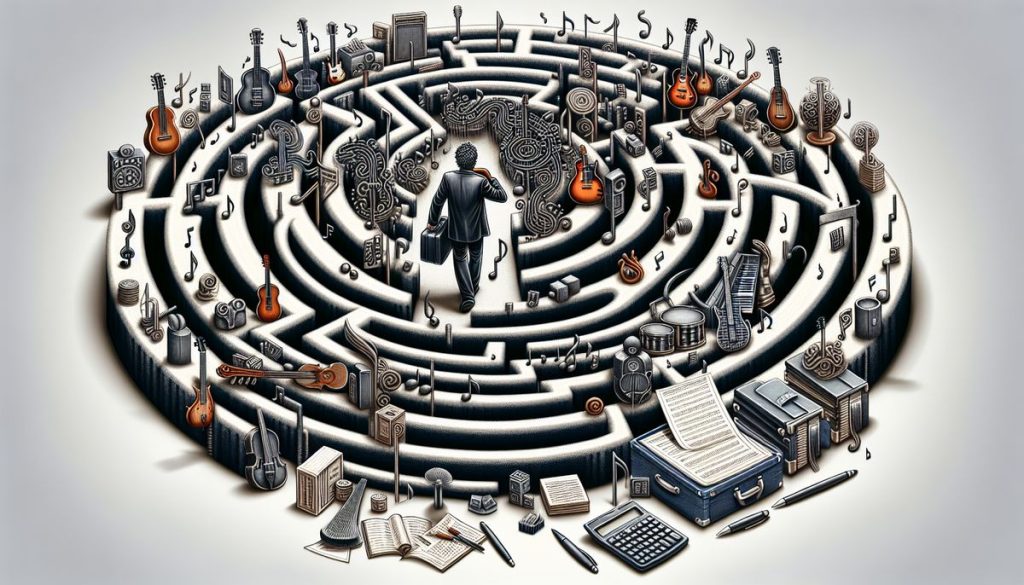Radio Edit: What Makes a Good One
Written by DJ Prodigee on Tue Jan, 2024
Radio editing is an art that requires skill and creativity. In this article, we will explore what makes a good radio edit, from the power of bleeping to the fine line between funny and offensive. We will also delve into the techniques of crafting hilarious radio edits, including timing and delivery, substitute words, seamless transitions, and unexpected sound effects. Additionally, we will discuss the dos and don’ts of radio editing, such as avoiding awkward silence and steering clear of overused censorship techniques. Finally, we will explore the evolution of radio editing, from censorship to comedy gold, and the impact of social media on radio edits.
Key Takeaways
- Radio editing is an art that requires skill and creativity.
- Timing and delivery are crucial in crafting hilarious radio edits.
- Seamless transitions and unexpected sound effects can enhance radio edits.
- Avoid awkward silence and overused censorship techniques in radio editing.
- The evolution of radio editing has seen it transform from censorship to comedy gold.
The Art of Radio Editing

Unleashing the Power of the Bleep
When it comes to radio editing, the bleep is your secret weapon. It’s like a superhero cape for your audio, hiding all the naughty words and turning them into hilarious moments. Just imagine, you can turn a curse word into a funny sound effect or a random word that makes absolutely no sense. It’s like magic! But remember, with great power comes great responsibility. Use the bleep wisely and sparingly, or else you might end up with a show that sounds like a malfunctioning censor machine.
When Censorship Becomes Comedy
When censorship takes a comedic turn, it’s like watching a magician perform a trick you never saw coming. Suddenly, the bleeps and blurs become the punchline, and you find yourself laughing at the absurdity of it all. It’s a delicate balance, though, because crossing the line from funny to offensive can happen in the blink of an eye. So how do radio editors navigate this fine line between humor and controversy? Let’s take a look.
The Fine Line Between Funny and Offensive
When it comes to radio editing, walking the fine line between funny and offensive can be a tricky task. Bold humor can be a great way to entertain listeners and create memorable moments, but it’s important to remember that what one person finds funny, another might find offensive. So how do you navigate this delicate balance? Here are a few tips:
- Know your audience: Understanding the demographics and preferences of your target audience is crucial. What may be funny to a younger crowd might not resonate with an older audience.
- Avoid stereotypes: Stereotypes can be offensive and perpetuate harmful biases. It’s best to steer clear of them and focus on clever wordplay or situational humor.
- Consider cultural sensitivities: Different cultures have different norms and sensitivities. Be mindful of cultural references and avoid jokes that may be insensitive or offensive.
- Test the waters: Before airing a radio edit, gather feedback from a diverse group of people to gauge their reactions. This can help you identify any potentially offensive content.
Remember, the goal is to entertain and engage listeners while respecting their boundaries. By finding the right balance between funny and offensive, you can create radio edits that leave a lasting impression.
Mastering the Art of Beep
When it comes to radio editing, mastering the art of beep is crucial. The beep is like the superhero of censorship, swooping in to save the day when a naughty word slips through. But it’s not just about slapping a beep on every curse word. Oh no, there’s a finesse to it, a delicate balance between funny and offensive. You have to know when to beep and when to let it slide, when to unleash the power of the bleep and when to hold back. It’s a skill that takes time and practice, but once you’ve mastered it, you’ll be the beep master extraordinaire!
The Secret Sauce of Radio Edits
When it comes to radio edits, there’s a secret sauce that can take your show from bland to grand. It’s all about finding the perfect balance between censorship and comedy, creating edits that are both funny and entertaining. But how do you find that sweet spot? Here are a few tips to help you master the art of radio edits:
- Timing and Delivery: The key to a hilarious radio edit is impeccable timing and delivery. Make sure your bleeps and censorships hit at just the right moment to maximize the comedic effect.
- Substitute Words: Finding the perfect substitute words is crucial. Look for words that sound similar to the original, but have a completely different meaning. It’s all about creating a seamless transition that keeps the conversation flowing.
- Seamless Transitions: Speaking of transitions, they should be smooth and seamless. Avoid abrupt cuts or awkward pauses. Use editing techniques to make the transition between censored and uncensored parts as natural as possible.
- Unexpected Sound Effects: Don’t be afraid to add some unexpected sound effects to your radio edits. They can enhance the comedic value and make the edit even funnier.
- Reverse Audio: Reverse audio is a powerful tool in radio editing. It can add a touch of mystery or create a comedic twist. Experiment with reversing certain words or phrases to see what kind of effect it creates.
Remember, the secret sauce of radio edits is finding the perfect balance between censorship and comedy. With a little practice and creativity, you can create edits that will have your listeners laughing out loud.
Crafting Hilarious Radio Edits

The Importance of Timing and Delivery
When it comes to radio editing, timing and delivery are key. Timing is everything in creating a hilarious radio edit. A well-timed bleep or beep can turn an ordinary sentence into a comedic masterpiece. It’s all about finding the perfect moment to censor or substitute words for maximum comedic effect.
But timing is just one piece of the puzzle. Delivery is equally important. The way you deliver the censored words or substitute phrases can make or break the joke. It’s all about the tone, the inflection, and the comedic timing. Remember, it’s not just what you say, but how you say it that makes it funny.
So, how do you master the art of timing and delivery in radio editing? Here are a few tips:
- Practice makes perfect. Experiment with different timing and delivery techniques to find what works best for you.
- Pay attention to the rhythm and flow of the conversation. Make sure your edits don’t disrupt the natural flow of the dialogue.
- Use unexpected sound effects to enhance the comedic timing. A well-placed sound effect can take a joke to the next level.
- Don’t be afraid to take risks. Sometimes the funniest edits are the ones that push the boundaries and surprise the audience.
Remember, when it comes to radio editing, timing and delivery are the secret ingredients to creating hilarious and memorable edits.
Finding the Perfect Substitute Words
When it comes to finding the perfect substitute words, you need to get creative. Think outside the box and come up with alternatives that will make your audience laugh. Remember, the goal is to keep the humor intact while still censoring the inappropriate content. Here are some tips to help you in your quest for the perfect substitute words:
- Use words that sound similar to the original but have a completely different meaning. For example, instead of saying ‘f**k’, you can say ‘duck’ or ‘luck’.
- Incorporate puns and wordplay into your substitutions. This adds an extra layer of humor to your edits.
- Don’t be afraid to get a little silly. Sometimes the funniest substitute words are the ones that are completely unexpected.
So go ahead, let your creativity run wild and find those perfect substitute words that will have your audience rolling with laughter!
Creating Seamless Transitions
When it comes to creating seamless transitions in your radio edits, it’s all about maintaining that natural flow. You want your edits to blend in so well that listeners won’t even notice the transitions happening. Here are a few tips to help you achieve that:
- Edit out unnecessary words, moments, or pauses.
- Cut out discourse markers or filled pauses, as long as it doesn’t disrupt the natural flow.
- Remove extended pauses.
- Get rid of obvious mistakes or awkward moments.
Remember, the key is to make sure your show still sounds natural and not over-edited. So go ahead and work your editing magic!
Adding Unexpected Sound Effects
When it comes to sound effects, the key is to surprise your listeners with the unexpected. Imagine their faces when they hear a squeaky toy sound effect after a serious statement or a fart noise after a dramatic pause. These unexpected sound effects can add a touch of humor and keep your audience engaged. Just remember to use them sparingly and strategically. Too many sound effects can be like a bad joke that falls flat. So, choose your moments wisely and let the unexpected sound effects work their magic!
The Magic of Reverse Audio
Ah, the magic of reverse audio! It’s like playing your favorite song backwards and discovering hidden messages from aliens or secret societies. But in the world of radio editing, reverse audio is more than just a fun gimmick. It’s a powerful tool that can add a touch of mystery and intrigue to your edits. Imagine creating a radio edit where the bleeped out word is revealed in reverse, leaving your listeners scratching their heads in confusion. Or using reverse audio to create a seamless transition between two segments, leaving your audience wondering how you did it. The possibilities are endless!
The Dos and Don’ts of Radio Editing

Avoiding Awkward Silence
When editing your radio show, one of the key things to keep in mind is to avoid awkward silence. Nobody wants dead air on the radio, unless you’re hosting a show for crickets. So, how do you ensure that your show keeps flowing without any awkward pauses? Here are a few tips to help you out:
- Edit out unnecessary words, moments, or pauses.
- Cut out discourse markers (you know’, so) or filled pauses (um, er), so long as it doesn’t disrupt the natural flow of the conversation.
- Edit out extended pauses.
- Remove obvious mistakes or awkward moments, like if you speak over your guest or any loud coughs, sneezes, and background noises.
Remember, the goal is to maintain a natural flow while keeping the energy up and the audience engaged. So, keep those edits coming and make sure your show is as smooth as butter!
Steering Clear of Overused Censorship Techniques
Let’s face it, the classic bleep has been done to death. It’s like the laugh track of radio edits—once a staple, now a cliché. To keep your listeners engaged and chuckling, you need to mix things up. Here’s a cheeky guide to freshening up your censorship repertoire:
- Experiment with sound effects: A quack instead of a bleep? Why not!
- Play with silence: A well-timed pause can be more powerful than any sound.
- Get creative with language: ‘Fudge’ and ‘ship’ can sail you through stormy words.
Remember, the goal is to maintain the essence of the content without making your audience roll their eyes at yet another predictable edit. > Pro Tip: Always ensure your edits don’t disrupt the natural flow of the conversation. It’s a fine art, balancing the need to sanitize content with keeping the original flavor. So, wield your editing scissors with care and let your creativity flow!
Keeping it PG-13: Tips for Family-Friendly Edits
When it comes to creating family-friendly radio edits, it’s important to strike a balance between keeping the content clean and maintaining the entertainment value. Here are a few tips to help you navigate the world of PG-13 edits:
- Choose your substitute words wisely: Instead of resorting to the usual bleeps and blurs, get creative with your word choices. Find substitutes that are funny and lighthearted, but still convey the intended message.
- Embrace the power of sound effects: Adding unexpected sound effects can add a comedic twist to your edits. Think boings, honks, and squeaks to replace explicit words or phrases.
- Timing is everything: The key to a successful radio edit is impeccable timing. Make sure your edits seamlessly blend into the original content, creating a smooth and natural flow.
- Don’t be afraid to embrace the bleep: Sometimes, a well-placed bleep can be funnier than any substitute word. Use it sparingly and strategically to enhance the comedic effect.
Remember, the goal is to create edits that are suitable for all ages without sacrificing the humor and entertainment value. So go ahead, get creative, and make those radio edits shine!
When to Embrace the Bleep and When to Let it Slide
When it comes to deciding whether to embrace the bleep or let it slide, you have to trust your comedic instincts. Sometimes, a well-placed bleep can turn an ordinary sentence into a hilarious punchline. But be careful not to overuse it, or it might lose its comedic effect. Here are a few tips to help you navigate the bleeping waters:
- Embrace the bleep when it adds surprise or shock value to a joke or statement.
- Let it slide when the bleep would detract from the humor or disrupt the flow of the conversation.
- Remember, timing is everything. A perfectly timed bleep can make all the difference between a funny moment and a missed opportunity.
As they say, bleep happens, but with the right judgment, you can turn it into comedy gold!
The Evolution of Radio Editing
From Radio Censorship to Comedy Gold
Radio censorship has come a long way, or should we say, a long beep! What was once considered too risque for the airwaves is now comedy gold. It’s amazing how shifting mores and changing times can turn a controversial song into a hilarious punchline. Take the iconic debut single ‘Relax’ by Frankie Goes To Hollywood, for example. This song was initially censored and banned by some radio stations due to its risque lyrics. But despite the controversy, it went on to become a massive hit and a staple of radio playlists. It just goes to show that sometimes, a little censorship can lead to a lot of laughs!
Pushing the Boundaries: Controversial Radio Edits
When it comes to pushing the boundaries of radio edits, there are some artists who take it to a whole new level. From songs with risque lyrics to tracks that are simply too rude for radio, these controversial edits have caused quite a stir. But why do artists choose to create such provocative edits? Well, it’s all about making a statement and grabbing the listener’s attention. Whether it’s using explicit language or tackling taboo subjects, these edits are designed to shock and entertain. So, the next time you hear a controversial radio edit, remember that it’s all part of the art of pushing boundaries.
The Rise of Memorable Bleep Moments
Ah, the bleep moments. Those instances when a well-placed censor sound turns an ordinary radio edit into a hilarious and unforgettable experience. Whether it’s a strategically placed beep or a creative substitute word, these bleep moments have become a staple in radio editing. But what makes a bleep moment truly memorable? Let’s dive into the world of bleeps and discover the secrets behind their comedic power.
1. Timing is Everything
In the world of bleep moments, timing is everything. The perfect bleep can turn an ordinary sentence into a comedic masterpiece. It’s all about finding that sweet spot where the bleep hits at just the right moment, creating a punchline that leaves listeners in stitches.
2. The Element of Surprise
One of the keys to a memorable bleep moment is the element of surprise. When a bleep comes out of nowhere, catching listeners off guard, it adds an extra layer of humor to the edit. It’s like a comedic curveball that keeps the audience on their toes.
3. The Power of Substitution
Substitute words are the secret sauce of bleep moments. Finding the perfect word to replace the bleeped-out profanity can take a radio edit from funny to downright hilarious. It’s all about choosing a word that fits the context and adds an unexpected twist to the original phrase.
4. Embracing the Absurd
Sometimes, the funniest bleep moments are the ones that embrace the absurd. It’s when the substitute word is so outlandish or nonsensical that it becomes a joke in itself. These moments remind us that radio editing is not just about censorship, but also about creating comedy gold.
So, the next time you hear a bleep moment on the radio, remember the artistry behind it. It’s not just a simple censor sound; it’s a carefully crafted comedic gem that brings laughter to the airwaves.
The Impact of Social Media on Radio Edits
Social media has revolutionized the way we consume and share content, and radio edits are no exception. With platforms like Twitter, Facebook, and Instagram, radio edits have the potential to go viral and reach a wider audience than ever before. Radio edits that are funny, clever, or controversial can quickly gain traction and become memorable moments in pop culture.
But social media also presents challenges for radio edits. The immediacy of these platforms means that radio stations and DJs need to be quick in producing and sharing their edits to stay relevant. They also need to be mindful of the potential backlash or controversy that can arise from their edits.
In this digital age, radio edits have become a form of entertainment in their own right. They have the power to spark conversations, generate memes, and even influence the music industry. So, whether you’re a radio station, a DJ, or just a listener, keep an eye out for those viral radio edits that are sure to make you laugh, think, and maybe even dance.
Welcome to MizFitz Radio, the home of the independent artist. In this article section, we will explore the fascinating evolution of radio editing. From its humble beginnings to the modern digital age, radio editing has undergone significant changes that have shaped the way we listen to music and engage with radio broadcasts. Join us on this journey as we delve into the history, techniques, and impact of radio editing. Discover how radio editing has revolutionized the music industry and paved the way for independent artists to showcase their talent. Visit MizFitz Radio today and experience the power of independent music.
In Conclusion
Creating radio edits is like being a DJ for your show, mixing and blending the perfect elements to create an unforgettable experience. From trimming and balancing to creating a compelling story, every edit should be intentional and entertaining. So grab your headphones, fire up your editing software, and let your creativity flow. Remember, the key to a good radio edit is to have fun and keep your audience wanting more. Happy editing!







